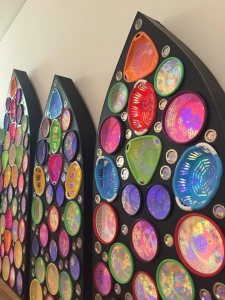Seeing the Creation of Art From an International Lens

This fall semester I worked with the Bates College Museum of Art curating the show, Phantom Punch, which exclusively includes artwork from young, contemporary artists from Saudi Arabia. I was immediately drawn into the project and loved the show’s incorporation of a wide variety of mediums, and the fact that I was looking at art that came from a country I have never visited. Just by seeing some of these pieces, I had a newfound respect and admiration for Saudi art and culture. When I first began working on the project, I was researching the artists and the artistic movement occurring in contemporary Saudi Arabia. I soon learned that freedom of expression is not guaranteed in Saudi art. If for example a piece of art is created that might be considered “culturally insensitive” in some form, it could be banned from exhibition. In addition to this, every exhibit has to first be reviewed by the Ministry of Culture and Information before being shown to the public. This concept of having art approved before being seen by the public eye was shocking to me and unfamiliar. I became more grateful and appreciative of my own freedom of expression. Growing up in a family of artists and aesthetically-minded people in the city of Los Angeles, I was surrounded by unique and sometimes controversial art. It was often the controversial art that drew me in the most and that inspired me to create something equally as thought-provoking and meaningful. It’s hard for me to imagine that such works have to be reviewed and accepted being they are shown to people around the world.
Learning about the unique artistic movement happening in Saudi Arabia intrigued me in a new way. These artists are creating work that might upset political customs of approach, however, the result is something widely accepted as beautiful. It is important to remember that art is not necessarily a free form of expression in every country. Art is often created for art’s sake, but in many cases, it is created with a social message or a political challenge. Many of the pieces I looked at while working on “Phantom Punch” were equally as beautiful as they were socially and politically relevant. They question gender roles, the role of religion and the role of art, while also providing images of beauty and grace. They raise socially relevant questions and leave the viewer with a colorful vision of Saudi culture. It was enlightening to see art from a country that has such restrictions and it was empowering to see young artists publicly displaying social messages relevant to their country. What excited me the most about this show was the fact that all the artists are so young. This new generation of Saudi artists is innovative and fresh-minded. They present a beautiful, political, and cultural story of Saudi Arabia.
By,
Emerson Krull
Environmental Science